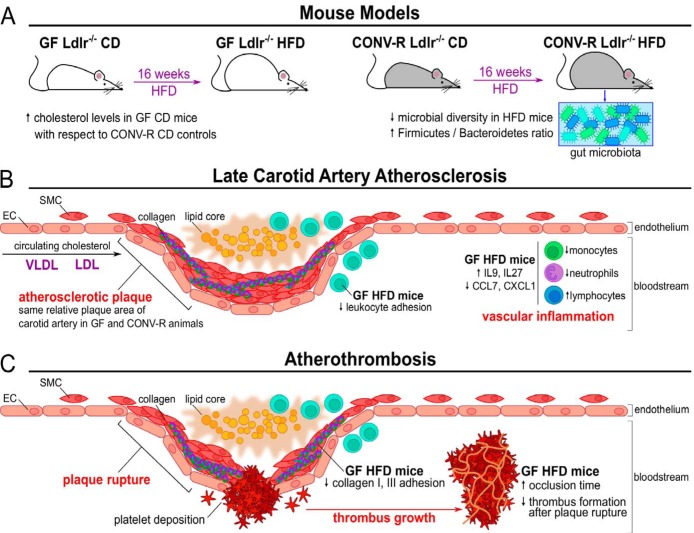FIG 6.
Effects of gut microbiota on late carotid artery atherosclerosis and atherothrombosis. (A) For this study, either GF or CONV-R Ldlr−/− mice on a conventional diet (CD) were fed for 16 weeks with a high-fat diet (HFD), thus resulting in the onset and progression of atherosclerosis. For CONV-R Ldlr−/− mice, the HFD yielded a reduced diversity of the commensal microbiota, with an increase in the Firmicutes/Bacteroidetes ratio. Interestingly, when fed with a CD, GF Ldlr−/− mice presented higher cholesterol levels with respect to CONV-R counterparts. (B) After cholesterol accumulation, resulting from deposition of VLDL and LDL lipoproteins, an atherosclerotic plaque presents a subendothelial lipid core with infiltrating leukocytes characterized by the accumulation of smooth muscle cells (SMC) from the tunica intima and tunica adventitia of the blood vessels. Although the relative plaque sizes at the carotid artery were unchanged between the two groups, GF animals showed altered vascular inflammatory parameters and immune cell populations. EC, endothelial cells. (C) During atherothrombosis, the plaque rupture yields to platelet deposition to the exposed subendothelial collagen, and subsequently to a bloodstream-circulating thrombus growing on the platelet plug. In this context, GF Ldlr−/− mice fed with a HFD presented lower yields of plaque rupture, collagen adhesion, and thrombus growth. Arterial occlusion time was increased in CD-fed GF C57BL/6J mice compared to CONV-R controls.

